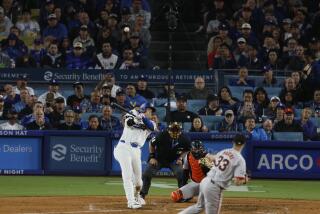The Cypres Sports Museum could feature the greatest collection of sports memorabilia in history
Only the lucky ones so far have made it inside the Cypres Sports Museum, now taking shape in a nondescript office building about a mile south of Staples Center. Admission to the memorabilia collection in downtown Los Angeles has been by invitation only, but next spring, owner Gary Cypres will open the doors to his treasure trove of baseball, football, golf, tennis and other sports memorabilia that he has amassed during a two-decade collecting binge.
Former Dodgers owner Peter O’Malley ranks the Dodgers’ section of the Cypres collection as “the best that I know of,” and is ecstatic that the museum will be open to the public. “It’s too good to only be seen by appointment. Schoolchildren, adults, collectors and baseball fans, not just from the U.S., but from Japan and all over the world should be able to see it.”
The museum’s crown jewel might be the uniform Babe Ruth wore during his barnstorming tour of Japan after the 1934 season, and that Cypres purchased for $800,000. Or maybe it’s the T206 Honus Wagner trading card that represents a Holy Grail among collectors — a similar one in perfect condition sold recently for $2 million.
Among the nearly 10,000 items in the 63-year-old businessman’s collection: an early Heisman Trophy, an original cornice stone from Yankee Stadium, a handful of infield dirt scooped from Ebbets Field before the first game was played in 1913 and a sign hung by the demolition company that leveled the fabled Brooklyn Dodgers ballpark in 1960.
Cooperstown is baseball, Canton sticks with football and Springfield revolves around basketball, but Cypres’ collection covers many sports. “His museum has such great breadth and depth,” said Dodgers owner Frank McCourt. “It goes far beyond the Dodgers and baseball to almost every sport. It’s an amazing little place.”
There are stories around every corner: Cast-iron putters. Rowing equipment. Original basketball hoops — the kind with closed bottoms. Game jerseys worn by Bill Russell, Kareem Abdul-Jabbar, Willis Reed and most of the NBA’s legendary big men. Leather football helmets from Red Grange’s era. A Dodgers’ 1981 World Series trophy. Babe Ruth’s shotgun, plus the travel trunk he hauled during the Japanese tour. The bat that Ruth used to swat his 58th and 59th home runs (it cost Cypres more than $400,000). A bench fashioned during the 1950s from balls and bats signed by such luminaries as Ruth, Ty Cobb, Cy Young and Dizzy Dean.
The museum has antique golf clubs, sports-themed arcade and board games dating to the 1800s and hundreds of movie posters featuring Sonja Heinie, Buster Crabbe and other athletes who made Hollywood star turns. The walls are covered with uniforms, championship pennants and analog scoreboards.
Los Angeles Sports Council Chairman Alan Rothenberg says local sports fans will embrace the museum when it opens, and that word will spread quickly among out-of-town fans. “Done right, it could become one of the ‘must’ stops for tourists,” said Rothenberg who has toured the museum. “It’s only a question of how much he chooses to expose it. It could become an icon.”
The New York-born Cypres, who played basketball at Hofstra University before going into business and settling in L.A., made his fortune in the finance, mortgage and travel agency businesses. He began collecting in the 1980s with a handful of stylish French tennis rackets that date to the 1800s. His collection mushroomed during the last decade and overflowed his house, attic and several storage bins. Four years ago he sold one of his businesses and turned the space into a museum. Cypres estimates its value, along with the building that houses it, at $30 million
Cypres serves as designer, curator and all-around museum handyman. He wants fans, particularly children, to get as close as possible to the exhibits and many items are out in the open, not under glass. He also is writing the panels that explain the exhibits.
Instead of subdued spotlights there are banks of fluorescent lights. “I like bright places, and many museums are dark,” Cypres said. And, as for the prospect of 100-year-old uniforms fading under the bright lights? “I figure that they’ve lasted for 100 years and are probably going to be OK for another 100 years.”
Experts say it would be hard to duplicate what Cypres has amassed. “A lot of people talk about opening this kind of museum, but nobody ever does it,” said David Hunt, owner of an Exton, Pa.-based sports auction house that helped Cypres build his collection.
One exhibit honors the imaginary young woman who issues the invitation to “Take Me Out to The Ballgame” in baseball’s unofficial anthem. (The little-known first line: “Katie Casey was baseball mad, had the fever and had it bad.”) Another will showcase a century-old stained glass window from a German elementary school that depicts an angel standing watch over children playing baseball.
What separates his museum from other collections, memorabilia experts said, is its broad scope and emphasis on technology that has changed sports.
The depth is evident in the baseball glove collection that includes some of the earliest, handball-like leather gloves, as well as subsequent gloves with such improvements as padding, webbing and pockets. There is a golf ball from the mid-1800s fashioned from wet feathers and stitched leather. When the golf ball dried out, the feathers expanded, the leather contracted and the golfer had a relatively hard object to swat — at least for a few rounds.
Cypres, who is married and has five children, jokingly refers to the items in his collection as “my children, my family.” And, like most proud parents, he has plenty of stories to tell.
He paid more than $400,000 for the 1941 Heisman Trophy, in part because he wanted one of the earliest trophies to have been awarded. He gladly paid a premium for University of Minnesota running back Bruce Smith’s trophy (the seventh handed out) because he already had a movie poster for “Smith of Minnesota,” which gave a Hollywood treatment to the athlete’s career.
One room houses 25 hauntingly beautiful oil paintings of such baseball Hall of Famers as Ruth, Cobb, Wagner and Willie Mays. A Detroit Tigers second baseman had commissioned the artwork to hang on the walls of his car dealership. They had languished in storage until Cypres bought them at auction.
On another occasion, Cypres waited 20 years for a collector to sell him a pair of baseball gloves that date to about the 1870s and are among the oldest in existence. “I knew where they were, I just had to wait to get my hands on them,” he said.
Cypres is an avid collector, according to McCourt, who got into an unintentional bidding war with him several years ago over the last big league game uniform that Ruth wore when he was a Dodgers first base coach in 1938. McCourt realized who won only later in the day during a telephone conversation with Cypres: “All of a sudden I realized he was the son-of-a-gun I was bidding against,” McCourt said.
“I probably ended up paying twice what I would have because we were bidding against each other,” Cypres said. “We don’t do that anymore.”
Cypres continues to juggle the museum layout to match his evolving vision. Separate rooms honor Ruth, Joe DiMaggio, the Yankees, and — given Cypres’ long-standing loyalties — the Brooklyn (and later, Los Angeles) Dodgers. The latter includes a hand-written letter from 1889 that welcomed the Dodgers into the National League.
Cypres isn’t done collecting.
In 1941 DiMaggio set a record that still stands by getting hits in 56 consecutive games. Cypres recently purchased the baseball that would have given DiMaggio his 57th consecutive game hit — had Cleveland Indians infielder Ken Keltner not grabbed it. DiMaggio subsequently autographed the ball, adding some kind words for Keltner. Cypres bought the ball at auction.
The one uncertainty, as Cypres fine-tunes exhibits and upgrades the museum to meet building codes, is the Los Angeles Community Redevelopment Agency’s proposal to dramatically reshape the surrounding neighborhood.
If he were forced to move, Cypres said that he would be hard-pressed to find another affordable location for such a large collection: “I’m not going to wait for the CRA to make up its mind. I’m going to open my museum,” he said.
greg.johnson@latimes.com
More to Read
Sign up for The Wild
We’ll help you find the best places to hike, bike and run, as well as the perfect silent spots for meditation and yoga.
You may occasionally receive promotional content from the Los Angeles Times.






